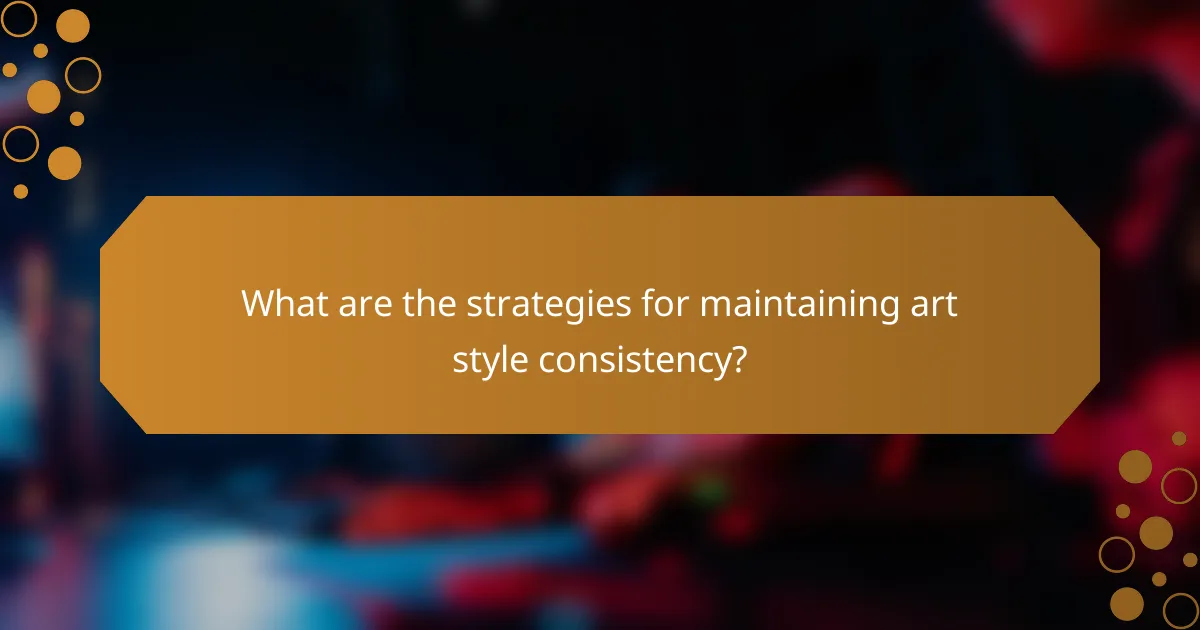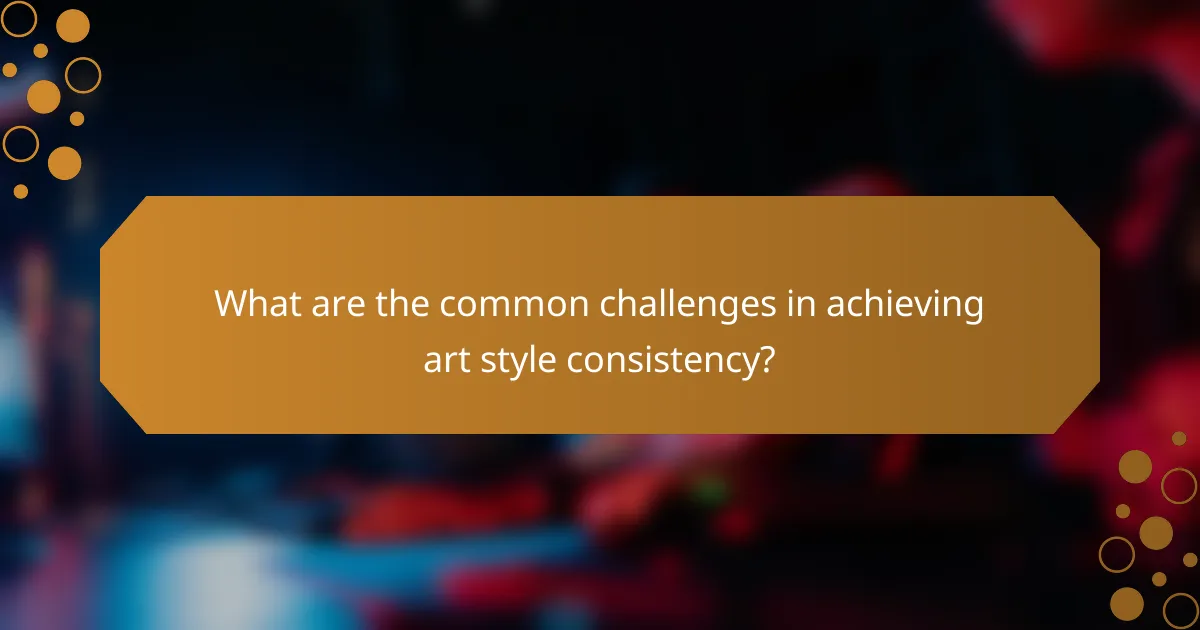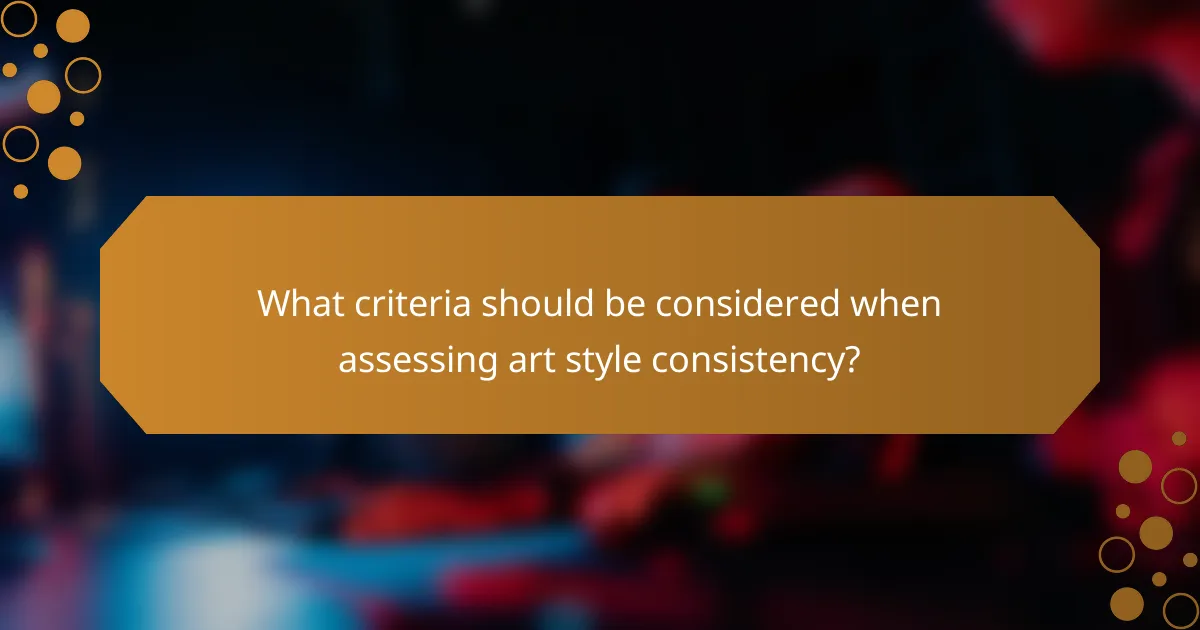Art style consistency is crucial for creating a cohesive visual identity that enhances user engagement and brand perception. By implementing specific strategies such as establishing a style guide and utilizing digital collaboration tools, teams can ensure that all artistic outputs align with a defined aesthetic. This uniformity fosters familiarity and trust among users, ultimately leading to improved experiences across digital products.

What are the strategies for maintaining art style consistency?
Maintaining art style consistency involves implementing specific strategies that ensure all artistic outputs align with a defined aesthetic. Key approaches include establishing a style guide, conducting regular workshops, utilizing digital collaboration tools, and creating feedback loops for ongoing improvement.
Establishing a clear style guide
A style guide serves as a foundational document that outlines the visual elements of your art style, including color palettes, typography, and imagery. This guide should be easily accessible to all team members and regularly updated to reflect any changes in the artistic direction.
When creating a style guide, consider including examples of both acceptable and unacceptable styles to clarify expectations. A well-structured guide can significantly reduce inconsistencies and help new team members quickly adapt to the established style.
Regular team workshops
Conducting regular workshops fosters collaboration and reinforces the importance of art style consistency among team members. These sessions can include hands-on activities, discussions about recent projects, and critiques to identify areas for improvement.
Workshops should be scheduled at consistent intervals, such as monthly or quarterly, to maintain momentum and ensure ongoing alignment with the style guide. Encourage open dialogue during these sessions to address any challenges or misunderstandings regarding the art style.
Utilizing digital tools for collaboration
Digital collaboration tools can enhance communication and streamline the creative process, making it easier to maintain art style consistency. Platforms like Slack, Trello, or Figma allow team members to share ideas, provide feedback, and track progress in real-time.
Choose tools that best fit your team’s workflow and ensure everyone is trained to use them effectively. This can help avoid miscommunications and ensure that all contributions adhere to the established art style.
Feedback loops for continuous improvement
Implementing feedback loops is crucial for refining art style consistency over time. Regularly soliciting input from team members and stakeholders can highlight areas where the style may be faltering and provide opportunities for constructive criticism.
Establish a routine for gathering feedback, such as post-project reviews or anonymous surveys, to encourage honest and open responses. Use this feedback to make informed adjustments to the style guide and improve future projects.

How does art style consistency impact digital products?
Art style consistency significantly influences digital products by creating a cohesive visual identity that enhances user engagement and brand perception. When a product maintains a uniform style, it fosters familiarity and trust among users, which can lead to better overall experiences.
Enhances brand recognition
Consistent art style strengthens brand recognition by ensuring that users can easily identify a product across various platforms. This visual uniformity helps to create a memorable impression, making it easier for customers to recall the brand when making purchasing decisions.
For example, companies like Apple and Coca-Cola utilize distinctive color palettes and design elements that remain consistent across their products and marketing materials. This approach not only reinforces their brand identity but also differentiates them from competitors.
Improves user experience
A consistent art style contributes to a smoother user experience by providing a familiar interface that users can navigate with ease. When design elements such as typography, colors, and icons are uniform, users can focus on functionality rather than adjusting to varying aesthetics.
To achieve this, designers should create a style guide that outlines the visual elements to be used throughout the product. This guide can include specifications for colors, fonts, and layout styles, ensuring that all team members adhere to the same standards.
Increases customer loyalty
Art style consistency can lead to increased customer loyalty by establishing a strong emotional connection with users. When customers feel a sense of familiarity and trust with a brand’s visual identity, they are more likely to return and recommend the product to others.
To cultivate this loyalty, brands should engage with their audience through consistent messaging and visuals across all touchpoints, including social media, websites, and advertising. This holistic approach reinforces the brand’s values and mission, making it more relatable to customers.

What are the common challenges in achieving art style consistency?
Achieving art style consistency can be challenging due to various factors that affect how artists interpret and execute a visual style. These challenges can lead to discrepancies in the final output, impacting the overall coherence of a project.
Diverse team interpretations
When working with a diverse team, individual interpretations of the art style can vary significantly. Each artist may bring their unique perspective, which can result in inconsistencies in color palettes, shapes, and overall aesthetics.
To mitigate this, establish a clear style guide that outlines key elements such as color schemes, character designs, and visual themes. Regular team reviews can also help ensure that everyone is aligned and adhering to the established guidelines.
Rapid project timelines
Fast-paced project timelines often pressure artists to prioritize speed over consistency, leading to rushed decisions that can compromise the art style. When time is limited, artists may skip important steps in the creative process, resulting in a disjointed visual output.
To counteract this, set realistic deadlines that allow for adequate time to refine the art. Incorporating buffer periods for feedback and revisions can also help maintain consistency without sacrificing quality.
Lack of resources or tools
A lack of appropriate resources or tools can hinder artists’ ability to achieve a consistent art style. Without access to the right software, hardware, or reference materials, artists may struggle to produce work that aligns with the desired aesthetic.
Investing in quality tools and providing access to comprehensive resources can significantly enhance the team’s ability to maintain consistency. Additionally, offering training sessions on specific tools or techniques can empower artists to better adhere to the established style.

What criteria should be considered when assessing art style consistency?
When assessing art style consistency, it’s essential to evaluate how well the visual elements align with the overall brand identity, maintain uniformity across different platforms, and reflect feedback from the target audience. These criteria help ensure that the art style effectively communicates the intended message and resonates with viewers.
Alignment with brand identity
Art style should reflect the core values and personality of the brand. This means using colors, shapes, and imagery that are consistent with the brand’s mission and vision. For example, a luxury brand might opt for a minimalist and elegant style, while a playful children’s brand may use bright colors and whimsical illustrations.
To assess alignment, create a style guide that outlines key visual elements and their intended emotional responses. Regularly review your art to ensure it adheres to this guide, making adjustments as necessary to maintain coherence.
Consistency across platforms
Maintaining a consistent art style across various platforms is crucial for brand recognition. This includes social media, websites, print materials, and advertisements. Each platform may have different specifications, but the core visual elements should remain unchanged to create a unified brand presence.
Consider developing templates for each platform that incorporate your established art style. This can streamline the design process and ensure that all visual content adheres to the same standards, regardless of where it appears.
Feedback from target audience
Gathering feedback from your target audience is vital for assessing art style consistency. Audience preferences can vary widely, and their insights can help identify areas where the art style may not resonate as intended. Conduct surveys or focus groups to gather opinions on visual elements and overall impressions.
Use this feedback to make informed adjustments to your art style. Regularly revisiting audience perceptions can help ensure that your visuals remain relevant and engaging, ultimately enhancing brand loyalty and recognition.

What tools can assist in maintaining art style consistency?
Several tools can help ensure art style consistency across projects, including design software, collaboration platforms, and project management applications. Utilizing these tools effectively can streamline workflows and enhance the overall quality of artistic output.
Adobe Creative Cloud
Adobe Creative Cloud offers a suite of applications like Photoshop, Illustrator, and InDesign that are essential for maintaining art style consistency. These tools allow artists to create and edit graphics while utilizing shared assets, such as color palettes and typography, ensuring a unified visual language across different pieces.
To maximize consistency, artists can create style guides within Adobe applications that outline specific design elements, including logos, color schemes, and font choices. Regularly updating these guides as projects evolve helps keep all team members aligned.
Figma for collaborative design
Figma is a powerful web-based design tool that facilitates real-time collaboration among team members, making it easier to maintain art style consistency. With features like shared libraries and design systems, Figma allows designers to access and use standardized components across various projects.
To ensure consistency, teams should establish a shared design system within Figma that includes components, styles, and guidelines. This system should be regularly reviewed and updated to reflect any changes in the overall art direction.
Trello for project management
Trello is an effective project management tool that helps teams organize tasks and track progress, which is crucial for maintaining art style consistency. By creating boards for different projects, teams can visually manage workflows and ensure that all design elements adhere to established guidelines.
To enhance consistency, teams should set clear deadlines and assign specific tasks related to style checks within Trello. Regular check-ins can help identify any deviations from the established art style early in the process, allowing for timely corrections.

What are the benefits of art style consistency in marketing?
Art style consistency in marketing enhances brand recognition and builds trust with consumers. By maintaining a unified visual approach, businesses can effectively communicate their values and messages, leading to stronger customer loyalty.
Creates a cohesive brand message
A cohesive brand message is crucial for effective marketing. When all visual elements, from logos to advertisements, share a consistent art style, they reinforce the brand’s identity and values. This uniformity helps consumers quickly recognize and relate to the brand.
To achieve a cohesive message, businesses should establish clear guidelines for their visual elements, including color palettes, typography, and imagery. For example, a tech company might use sleek, modern designs with a limited color scheme to convey innovation and sophistication.
Common pitfalls include using varying styles across different platforms or campaigns, which can confuse consumers. Regularly reviewing marketing materials against established guidelines can help maintain consistency and clarity in messaging.
